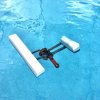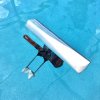Hello fellow Mavic2 pilots,
I've seen floats on Amazon made with pool noodles, but the first big issue is weight. 9 oz for a 32oz Mavic 2 represents 28% extra weight, which the drone is not designed for. This creates an over-load to the motors, and potential failure of some sort... sooner or later. The milder problem is reduced battery time due to over-weight.
The second problem is stability on the water, because the C.G. of the arrangement is high, so if not stable enough the Mavic2 will flip-over and get all the electronics wet (... total loss).
Bigger floats are better, but then you get into aerodynamic problems, like having too much lateral area, which affects not only battery performance but also how the drone fights the wind. If you exceed certain amount of lateral area, you may have trouble hovering or flying in high wind.
So you need to define your mission. Do you really want to land on water every day? Why? ... Why risk a $1300+ piece of sophisticated equipment just to see it floating on a lake?
If the objective is to add piece of mind while flying over water and save your air-frame in case of an accident, then that's different.
It's possible to build a LIGHT frame with floats that will land on calm water if there is an auto-land due to a battery problem. Worst case ... if the Mavic2 falls out of control (and possibly flips during a hard landing) due to a hawk attack, prop/motor problem, then at least you will be able to rescue the air-frame, have better chances of locating the wreck, and refreshing (if you have the plan) or repair it.
I've been working on the following attachment for the Mavic 2 made with composite materials. My design currently weights only 2.5 oz (less than 8% extra weight for the Mavic2 ). It attaches with good-old rubber-band technology (proven method used with Radio-Control for over 100 years) for quick mounting and quick battery change. It installs in 10 seconds, and stays put even in case of a water-hit. No screws to deal with, always fits tight, these pontoons are made of a single piece composite materials.
Advantages:
- Take-off and land almost anywhere, wet grass, tall grass, sand, mud, on top of a hedge, even water (although I don't recommend to actually land on water if you have other alternatives)
- Peace-of-Mind when flying over water, canals, lakes, the ocean
- Able to "grab" the Mavic2 if flying from a boat, without fear of the props catching your fingers
- Visibility is much better, you can spot the Mavic from further away (increases visual range). Painting them in custom colors is possible.
- Looks really cool
Dis-advantages:
- Might reduce performance by 5% - 10% (maybe lose 2 - 3 mins of flight time)
- Will fly well on winds up to 12 - 13 knots (14 - 15 mph). Above this you can still fly but you will need to fight the wind (and probably fly on the P-mode)
- If a strong crosswind is present, you may see the floats on the edge of the screen momentarily (similar issue as the props coming into view)
I've been flying with them for some time and I really feel no big difference on the handling, except in high-wind conditions.
Anybody interested? Any comments will be welcome.
Alex
Here are some photos:
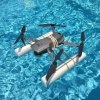
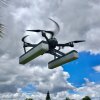
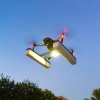
I've seen floats on Amazon made with pool noodles, but the first big issue is weight. 9 oz for a 32oz Mavic 2 represents 28% extra weight, which the drone is not designed for. This creates an over-load to the motors, and potential failure of some sort... sooner or later. The milder problem is reduced battery time due to over-weight.
The second problem is stability on the water, because the C.G. of the arrangement is high, so if not stable enough the Mavic2 will flip-over and get all the electronics wet (... total loss).
Bigger floats are better, but then you get into aerodynamic problems, like having too much lateral area, which affects not only battery performance but also how the drone fights the wind. If you exceed certain amount of lateral area, you may have trouble hovering or flying in high wind.
So you need to define your mission. Do you really want to land on water every day? Why? ... Why risk a $1300+ piece of sophisticated equipment just to see it floating on a lake?
If the objective is to add piece of mind while flying over water and save your air-frame in case of an accident, then that's different.
It's possible to build a LIGHT frame with floats that will land on calm water if there is an auto-land due to a battery problem. Worst case ... if the Mavic2 falls out of control (and possibly flips during a hard landing) due to a hawk attack, prop/motor problem, then at least you will be able to rescue the air-frame, have better chances of locating the wreck, and refreshing (if you have the plan) or repair it.
I've been working on the following attachment for the Mavic 2 made with composite materials. My design currently weights only 2.5 oz (less than 8% extra weight for the Mavic2 ). It attaches with good-old rubber-band technology (proven method used with Radio-Control for over 100 years) for quick mounting and quick battery change. It installs in 10 seconds, and stays put even in case of a water-hit. No screws to deal with, always fits tight, these pontoons are made of a single piece composite materials.
Advantages:
- Take-off and land almost anywhere, wet grass, tall grass, sand, mud, on top of a hedge, even water (although I don't recommend to actually land on water if you have other alternatives)
- Peace-of-Mind when flying over water, canals, lakes, the ocean
- Able to "grab" the Mavic2 if flying from a boat, without fear of the props catching your fingers
- Visibility is much better, you can spot the Mavic from further away (increases visual range). Painting them in custom colors is possible.
- Looks really cool
Dis-advantages:
- Might reduce performance by 5% - 10% (maybe lose 2 - 3 mins of flight time)
- Will fly well on winds up to 12 - 13 knots (14 - 15 mph). Above this you can still fly but you will need to fight the wind (and probably fly on the P-mode)
- If a strong crosswind is present, you may see the floats on the edge of the screen momentarily (similar issue as the props coming into view)
I've been flying with them for some time and I really feel no big difference on the handling, except in high-wind conditions.
Anybody interested? Any comments will be welcome.
Alex
Here are some photos:






